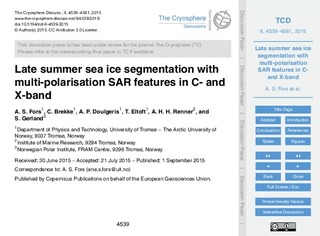| dc.identifier.citation | Fors, A. S., Brekke, C., Doulgeris, A. P., Eltoft, T., Renner, A. H. H., and Gerland, S.: Late-summer sea ice segmentation with multi-polarisation SAR features in C and X band, The Cryosphere, 10, 401-415, doi:10.5194/tc-10-401-2016, 2016. | nb_NO |
| dc.description.abstract | In this study, we investigate the potential of sea ice segmentation by C- and X-band multi-polarisation synthetic aperture radar (SAR) features during late summer. Five high-resolution satellite SAR scenes were recorded in the Fram Strait covering iceberg-fast first-year and old sea ice during a week with air temperatures varying around 0 °C. Sea ice thickness, surface roughness and aerial photographs were collected during a helicopter flight at the site. Six polarimetric SAR features were extracted for each of the scenes. The ability of the individual SAR features to discriminate between sea ice types and their temporal consistency were examined. All SAR features were found to add value to sea ice type discrimination. Relative kurtosis, geometric brightness, cross-polarisation ratio and co-polarisation correlation angle were found to be temporally consistent in the investigated period, while co-polarisation ratio and co-polarisation correlation magnitude were found to be temporally inconsistent. An automatic feature-based segmentation algorithm was tested both for a full SAR feature set and for a reduced SAR feature set limited to temporally consistent features. In C band, the algorithm produced a good late-summer sea ice segmentation, separating the scenes into segments that could be associated with different sea ice types in the next step. The X-band performance was slightly poorer. Excluding temporally inconsistent SAR features improved the segmentation in one of the X-band scenes. | nb_NO |

